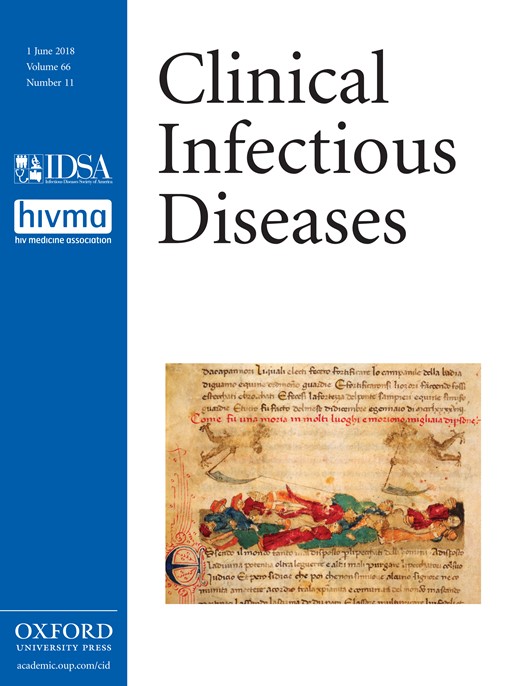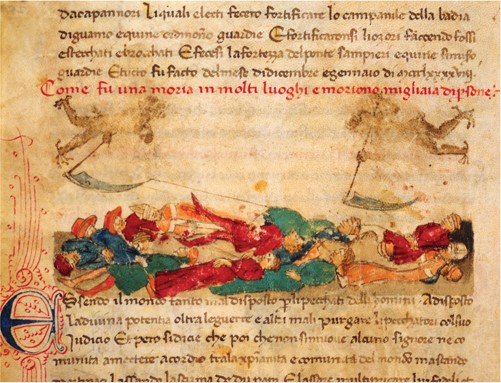
Cover image

Volume 66, Issue 11, 1 June 2018
NEWS
News
IN THE LITERATURE
In the Literature
ARTICLES AND COMMENTARIES
Antibiotic Resistance and the Risk of Recurrent Bacteremia
Antibiotic nonsusceptibility was consistently associated with higher risks of recurrent bacteremia, but the estimated number of additional recurrent episodes in the Netherlands (40 per year) was rather limited.
Burden of Respiratory Syncytial Virus Infection in South African Human Immunodeficiency Virus (HIV)-Infected and HIV-Uninfected Pregnant and Postpartum Women: A Longitudinal Cohort Study
Respiratory syncytial virus (RSV) infection was associated with respiratory illness during pregnancy and postpartum in women. Vaccination during pregnancy against RSV could benefit the mother, primarily against nonfebrile illness, and her infant.
Respiratory Syncytial Virus During Pregnancy
Contribution of Maternal Antiretroviral Therapy and Breastfeeding to 24-Month Survival in Human Immunodeficiency Virus-Exposed Uninfected Children: An Individual Pooled Analysis of African and Asian Studies
Pooled results from 21 studies involving more than 19 000 human immunodeficiency virus–exposed but uninfected children show that an estimated two-thirds of infant deaths are attributable to lack of antiretroviral treatment for mothers, low birth weight, never being breastfed, and mother’s death.
Detecting Infections Rapidly and Easily for Candidemia Trial, Part 2 (DIRECT2): A Prospective, Multicenter Study of the T2Candida Panel
T2Candida, a nanodiagnostic panel that detects Candida directly within whole blood, was 89% sensitive for diagnosing candidemia at the time of positive blood cultures. In patients who received antifungal therapy, T2Candida identified bloodstream infections that were missed by blood cultures.
New Molecular Method for Detection of Candidemia, but Don’t Forget the Blood Cultures
ACTG A5353: A Pilot Study of Dolutegravir Plus Lamivudine for Initial Treatment of Human Immunodeficiency Virus-1 (HIV-1)–infected Participants With HIV-1 RNA <500000 Copies/mL
Dolutegravir plus lamivudine was virologically effective and safe in treatment-naive individuals with human immunodeficiency virus type 1 RNA up to 500 000 copies/mL. A participant who experienced failure developed the M184V lamivudine and the R263R/K integrase resistance mutations.
A Double-Blind, Randomized Trial of High-Dose vs Standard-Dose Influenza Vaccine in Adult Solid-Organ Transplant Recipients
This randomized trial demonstrates superior immunogenicity of high-dose influenza vaccine compared to standard-dose trivalent vaccine in immunosuppressed organ transplant recipients. High doses of mycophenolate were associated with reduced immunogenicity.
Durability and Long-term Clinical Outcomes of Fecal Microbiota Transplant Treatment in Patients With Recurrent Clostridium difficile Infection
A total of 137 patients were contacted after fecal microbiota transplantation (FMT) for recurrent Clostridium difficile infection. At median 22 months follow-up, 82% were free of C. difficile recurrence and 95% would undergo FMT if they had recurrent C. difficile.
Daily and Nondaily Oral Preexposure Prophylaxis in Men and Transgender Women Who Have Sex With Men: The Human Immunodeficiency Virus Prevention Trials Network 067/ADAPT Study
Daily PrEP dosing recommendations led to a greater likelihood of protective drug concentrations in the Harlem cohort of men and transgender women who have sex with men, while daily and nondaily regimens led to comparably favorable outcomes in Bangkok.
Tennessee’s In-state Vulnerability Assessment for a “Rapid Dissemination of Human Immunodeficiency Virus or Hepatitis C Virus Infection” Event Utilizing Data About the Opioid Epidemic
We examined whether more granular data improved insights into county-level HIV/hepatitis C virus (HCV) outbreak vulnerability in Tennessee relative to recent national models. Sixteen counties unranked in prior analyses were identified as vulnerable. Importantly, opioid prescribing patterns significantly influenced increased risk for HIV/HCV.
Massive Iatrogenic Outbreak of Human Immunodeficiency Virus Type 1 in Rural Cambodia, 2014–2015
This study provided the serologic, genomic, and geospatial investigation of an iatrogenic outbreak that was recognized in rural Cambodia in 2014–2015, showing a massive and spatially localized outbreak of HIV, associated with HCV infections, but a lack of HBV diffusion.
Hepatitis C in Patients With Minimal or No Hepatic Fibrosis: The Impact of Treatment and Sustained Virologic Response on Patient-Reported Outcomes
Treatment of hepatitis C virus with the new direct-acting antivirals in patients with minimal or no hepatic fibrosis provides not only high rates of cure but also significant improvement in patient-reported outcomes (quality of life, fatigue, and work productivity).
Vivax Malaria Chemoprophylaxis: The Role of Atovaquone-Proguanil Compared to Other Options
In rafters to the Omo River, Ethiopia, atovaquone-proguanil provides causal (liver-schizont stage) prophylaxis for Plasmodium vivax but is ineffective against late, hypnozoite-reactivation-related attacks. Primaquine is the chemoprophylaxis agent of choice in areas where Plasmodium falciparum and Plasmodium vivax co-circulate.
A Multistate Outbreak of Human Salmonella Agona Infections Associated With Consumption of Fresh, Whole Papayas Imported From Mexico—United States, 2011
A multistate outbreak of Salmonella Agona was investigated in 2011. Through the combined use of interviews to identify suspect food vehicles, traceback, and novel techniques for analyzing distribution records, papayas from Mexico were identified as the source of the outbreak.
Silent Cerebral Small-Vessel Disease Is Twice as Prevalent in Middle-Aged Individuals With Well-Controlled, Combination Antiretroviral Therapy–Treated Human Immunodeficiency Virus (HIV) Than in HIV-Uninfected Individuals
Cerebral small-vessel disease was detected in 52% of middle-aged HIV-infected individuals with long-term viral suppression and 36% of frequency age- and sex-matched uninfected controls, with an adjusted odds ratio of 2.3 (95% confidence interval, 1.5–3.6).
Human Immunodeficiency Virus Antiretroviral Resistance and Transmission in Mother-Infant Pairs Enrolled in a Large Perinatal Study
More than 10% of previously untreated HIV-infected pregnant women and their infants had clinically significant antiretroviral drug-associated resistance mutations. Drug-related mutations did not appear to increase the risk of HIV transmission, but were transmitted to infants.
Increased Cervical Human Immunodeficiency Virus (HIV) RNA Shedding Among HIV-Infected Women Randomized to Loop Electrosurgical Excision Procedure Compared to Cryotherapy for Cervical Intraepithelial Neoplasia 2/3
Human immunodeficiency virus (HIV)–infected women with cervical intraepithelial neoplasia 2/3 randomized to loop electrosurgical excision procedure (LEEP) had higher mean cervical HIV RNA at 2 and 3 weeks after intervention compared to women treated with cryotherapy. Cervical HIV shedding after LEEP occurred both on and off antiretroviral therapy.
Human Immunodeficiency Virus Type 1 Group O Infection in France: Clinical Features and Immunovirological Response to Antiretrovirals
Our study shows that HIV-1 group O infection could have a milder natural evolution relative to HIV-1 group M, and that its current therapeutic management (excluding use of nonnucleoside reverse transcriptase inhibitor–based regimens), is highly efficient despite the genetic divergence of group O variants.
BRIEF REPORTS
Dolutegravir Plus Lamivudine Maintains Human Immunodeficiency Virus-1 Suppression Through Week 48 in a Pilot Randomized Trial
Urine Tuberculosis Lipoarabinomannan Predicts Mortality in Hospitalized Human Immunodeficiency Virus-Infected Children
REVIEW ARTICLE
A Systematic Review of Safety and Immunogenicity of Influenza Vaccination Strategies in Solid Organ Transplant Recipients
A booster-dose influenza vaccination strategy could improve immunogenicity in transplant recipients. Injection site reactions were more commonly observed in transplant recipients who received alternative influenza vaccination strategies.



